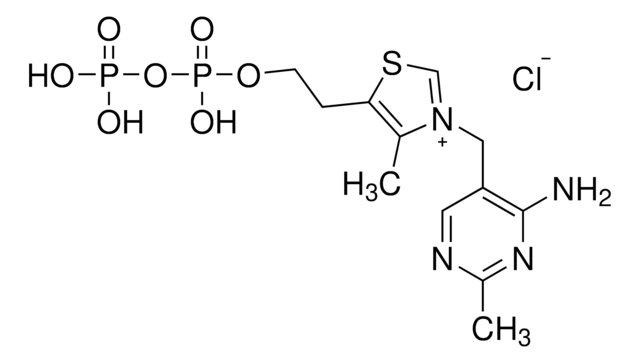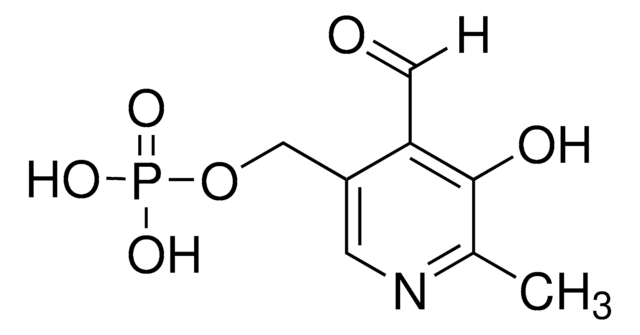C8754
Thiamine pyrophosphate
≥95%, powder
Synonyme(s) :
Aneurinepyrophosphoric acid, Cocarboxylase, Thiamine pyrophosphate chloride
About This Item
Produits recommandés
product name
Thiamine pyrophosphate, ≥95%
Niveau de qualité
Pureté
≥95%
Forme
powder
Solubilité
H2O: soluble 50 mg/mL, clear to very slightly hazy, colorless
Température de stockage
−20°C
Chaîne SMILES
CC1=C(CCOP(OP(O)(O)=O)(O)=O)SC=[N+]1CC2=C(N)N=C(C)N=C2.[Cl-]
InChI
1S/C12H18N4O7P2S.ClH/c1-8-11(3-4-22-25(20,21)23-24(17,18)19)26-7-16(8)6-10-5-14-9(2)15-12(10)13;/h5,7H,3-4,6H2,1-2H3,(H4-,13,14,15,17,18,19,20,21);1H
Clé InChI
YXVCLPJQTZXJLH-UHFFFAOYSA-N
Vous recherchez des produits similaires ? Visite Guide de comparaison des produits
Catégories apparentées
Application
- for the preparation of chitosan nano-particles
- as a standard for vitamin B1 and its derivative in high-performance
- liquid chromatography (HPLC) analysis
- immunofluorescence
Actions biochimiques/physiologiques
Mention d'avertissement
Warning
Mentions de danger
Conseils de prudence
Classification des risques
Skin Sens. 1
Code de la classe de stockage
11 - Combustible Solids
Classe de danger pour l'eau (WGK)
WGK 1
Point d'éclair (°F)
Not applicable
Point d'éclair (°C)
Not applicable
Équipement de protection individuelle
Eyeshields, Gloves, type N95 (US)
Certificats d'analyse (COA)
Recherchez un Certificats d'analyse (COA) en saisissant le numéro de lot du produit. Les numéros de lot figurent sur l'étiquette du produit après les mots "Lot" ou "Batch".
Déjà en possession de ce produit ?
Retrouvez la documentation relative aux produits que vous avez récemment achetés dans la Bibliothèque de documents.
Les clients ont également consulté
Articles
How thiamine and other cell culture components affect the performance of serum-free, protein-free cell culture systems used for biomanufacturing heterologous proteins including monoclonal antibodies. The page introduces the in vitro chemistry and biochemistry of thiamine.
Notre équipe de scientifiques dispose d'une expérience dans tous les secteurs de la recherche, notamment en sciences de la vie, science des matériaux, synthèse chimique, chromatographie, analyse et dans de nombreux autres domaines..
Contacter notre Service technique








